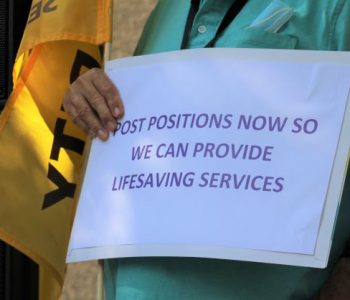 Connecticut
Connecticut
Hartford’s Yvonne Dimmett won’t be working this Labor Day. That is rare for Yvonne, who holds two full-time jobs, both demanding, care focused 40-hour positions. With overtime that often leads to 110-hour work weeks, as she recently detailed to me in a meeting of 1199NE leaders working in non-profit group homes caring for developmentally disabled adults.
Medicaid-funded agencies like Yvonne’s have been starved for funding since 2009, victims of successive austerity budgets to the tune of more than $500 million since the start of the Great Recession. These cuts haven’t just been numbers on a balance sheet—they’ve been lives affected, futures dimmed, and dreams deferred.
Last May, Yvonne and 1.500 1199NE members at six group home agencies decided to take a stand by striking against poverty wages for 21 days. It was a strike not against the employers, but legislated poverty.
These health care workers toil day in and day out at the bottom of the “care economy.” They are predominantly female, often Black and brown, and almost always motivated by a deep commitment to offer gentle compassion to those in need. Dimmett and other caregivers feed, bathe, and care for adult group home residents, as well as providing recreation, job support, and a listening ear.
The strike leveraged about $1.25/hr in raises for 20,000 workers in the industry —the biggest raise in years, but only up to a minimum of $18.50/hr— It’s a start, but not nearly enough to lift caregivers out of poverty. Among those on the picket lines were a few full-time workers who were, at that very moment, struggling with homelessness.
Why wasn’t more funding available, even with billions in budget surpluses? The answer lies in Connecticut’s fiscal guardrails. The guardrails are intended to protect the state’s financial health- a laudable goal and one of Governor Lamont’s signature achievements.
But for care work the guardrails are shackles, preventing spending on pressing, immediate needs. Yvonne’s work—work funded by the public sector Medicaid dollars—is undervalued and underfunded.
The guardrails are now impacting every aspect of working class life. Rising tuitions and program closures at state community colleges. School layoffs in virtually every city and town. Shrinking Husky eligibility. Long waits for state funded addiction and mental health treatment. Long term care workers with rising rents being forced into the streets. Nursing home residents without access to quality, nutritional food or safe, stable staffing of nurses aides and nurses.
Vice President Kamala Harris and Gov. Tim Walz, however, are making caregivers like Yvonne a centerpiece of their economic agenda. The Harris/Walz ticket reminds us that investing in the Care Economy isn’t just a moral imperative—it’s an economic one.
Quality child care improves life outcomes for children, and long-term elder care allows adults to remain in the workforce instead of stepping back to care for aging parents. Harris and Walz understand that to meet the growing demand for care workers, wages and benefits must rise.
As governor, Walz took bold steps to support care workers. Establishing a $25 per hour minimum wage for nursing home workers, creating a “wage board” to bring together unions, government, and nursing home operators to craft policy on workforce issues from education to free and fair union elections. Walz also made community college tuition-free for anyone making under $80,000 annually, opening doors for students and upskilling the workforce.
Today, less than 7% of private-sector workers are unionized, down from 30% in 1953. The impact of declining unionization on the American worker is clear. If the minimum wage had kept pace with productivity over the last 50 years, today it would stand at $26 an hour nationally.
And what of Connecticut workers? Balancing Connecticut’s budget has been among Lamont’s signature achievements—but the way he has chosen to accomplish this, paying down debt even at the expense of current, urgent care and education needs seems short-sighted and detached.
Our state’s high average income masks deep racial and economic inequality. The top 1% of income earners in Connecticut take home an average of $2.5 million annually, compared to $67,000 for the bottom 99%, the highest such disparity in the United States. According to the “Living Wage” calculator at the Massachusetts Institute of Technology, a single parent with one child requires an income of over $99,000 annually simply to break even, meaning many Connecticut workers struggle to pay basic expenses on one full-time job.
This approach continues to leave essential services and the people who provide them severely underfunded.
Part of Harris’s appeal to fund care work is recognition that it speaks powerfully to the very groups needed for Democrats to win, working women of all colors who are harried with low pay, expensive childcare, and rising costs.
The question now looms: In the 2025 budget session, will Connecticut’s legislature and governor rise to the occasion? Will they take the aggressive steps needed to uplift the care workers who represent a foundation upon which the future of the Democratic Party, and indeed, the nation, rests?
When does “fiscal responsibility” become a mask for elected leadership accepting GIlded Age inequality and the suffering that lands on the most core constituency of the Democratic Party, working women, white, Black, and brown residents like Yvonne who simply can’t escape poverty without literally laboring beyond exhaustion?
The care economy’s patients, students, and workforce deserve more.
Rob Baril is the President of SEIU 1199NE
This OP-ED was originally published in the Hartford Courant.








